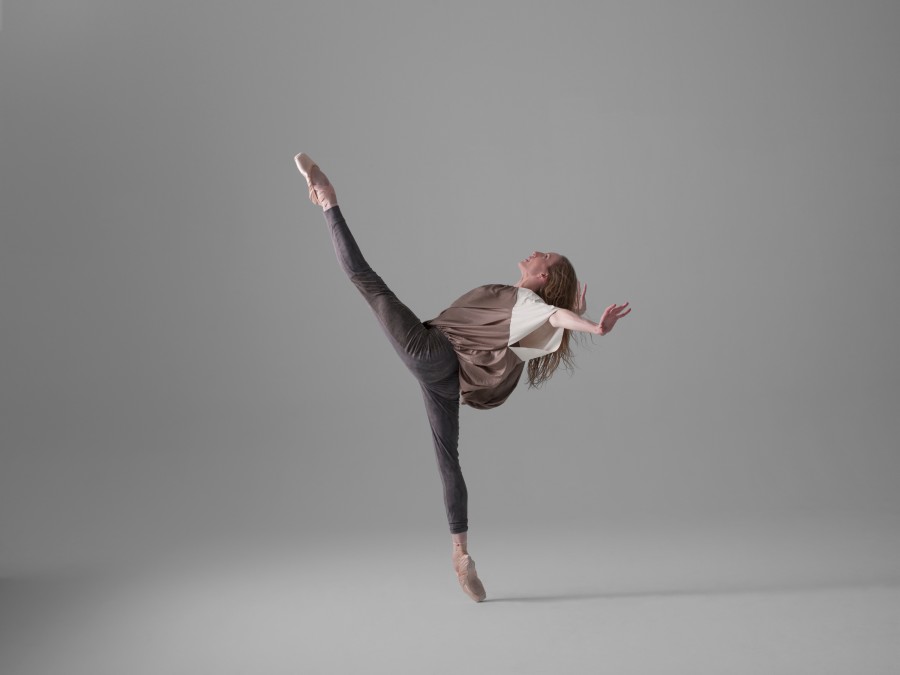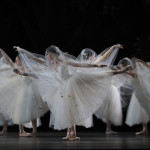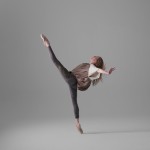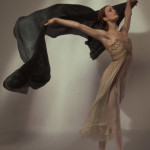A number of prominent dancers and artistic directors have spoken out in Pointe Magazine on the subject of body image in ballet.
Among them, Maria Kochetkova maintains:
At the end of the day, your height is not what determines if you get a job. It’s all about your dancing.
Stout words from a gutsy dancer who has risen above what others have perceived as her physical limitations. But this is simply not true for most dancers in her mold.

Yuan Yuan Tan and Maria Kochetkova in Piano Concerto #1 from Ratmansky’s SHOSTAKOVICH TRILOGY (Photo: Erik Tomasson)
Kochetkova makes unexciting lines in space. This is not because of any shortcomings of technique but because of the proportions of the instrument she was born with. But her compact size makes it easier for her to turn and jump than a taller, lankier dancer – and these things she does brilliantly. (I speak in generalities here: clearly there are some tall, long-limbed ballerinas who jump and turn miraculously.)
Kochetkova also has the advantage of timing: she is at her peak at a time when a number of gifted, short male dancers are also at theirs, and the demand for a gifted, short ballerina whom they can partner is high. Other dancers born with her physique and tenacity are unlikely to get the same breaks that she has gotten.
There is much wisdom in Wendy Whelan’s statement:
I try to remind myself that nobody has a perfect body and no dancer is a perfect dancer. True beauty lies within each of us to create for ourselves the best we can with what we have been given.
Yet even though standards of beauty may be shifting in a healthier direction, even as the notion of what constitutes a beautiful body line evolves with time, and even as sports medicine has advanced to give us better insight into what makes a strong, healthy athletic body, there is a bottom line when it comes to ballet: it’s an art form in which the men have to be able to lift the women.
Anecdotal evidence points to an increase in back injuries among male dancers as the women have become healthier and a little heavier. Male dancers are spending more time in the gym, building strength. Forward-thinking ballet training curricula consider female-male weight ratios when assigning partners, not simply height differences. Men have to be stronger and bigger these days if they are going to have a successful career in ballet. And with the increased popularity of male-male partnering in contemporary ballet, the strength requirement becomes even more imperative.
The concept of putting a dancer on ‘weight probation’ seems outdated and offensive. Yet many professional sports teams have a weight regime. The issue is more explosive in the ballet world because of the scandals around eating disorders and body dysmorphia – problems that used to be swept under the carpet but are more frequently aired now and, to varying degrees, addressed.
When a choreographer or artistic director is reluctant to cast a dancer because of her weight, does this reflect an outmoded, inflexible opinion of what dancers should look like on stage? Or is it a more practical consideration – is it because the role involves a lot of partnering and her weight presents a challenge? The answer is often both.
Whatever the prevailing aesthetic tastes, the incontrovertible fact is that the ideal body image of a ballerina has been sculpted over centuries almost exclusively by men. Even the handful of female choreographers and artistic directors have been influenced by – or have had to battle – standards set before they came along. Thus it’s vital for the survival of ballet to incorporate many more female voices in the programming and creation of new work, and in the revival of old. Arlene Croce wrote that ballet “exists in the interplay between memory and imagination.” The more disparate the sources of imagination, the more vibrant the art form becomes.








The language of classical ballet is not female. It was designed to use the female, even if unmaliciously. Ballerinas are to be seen- and only in a certain way- NOT heard.
Female choreographers have been inventive in attempting to reclaim this language as an accurate representation of their own wisdom- to reflect the intelligence of the female body and mind- but it can come across as inauthentic because it is. It is within the context of the male language/ system.
And I’ve wondered: if granted eternal sunshine of a spotless mind and this systematic patriarchal mishap is forgiven and dismissed, would a new world language of dance for women include ballet? Not likely. From an evolutionary standpoint, ballet doesn’t make sense. Women’s bodies and minds are naturally cyclical. They can bear children. They bleed monthly. Their own movement language might reflect this cyclical nature. Ballet is linear, very male. Lines, lines, lines.
And why would women continue to sacrifice their own longevity to perpetuate a male standard of beauty, stressing their bodies to the point of hip and knee replacement? Is there any other art form that requires such a sacrifice from its performer (besides male professional athletes who make quadruple what a ballerina makes)?
That’s harsh. Weren’t women exalted by the men who made ballets? Put on a pedestal? Admired because they could do things with ballet technique that men couldn’t do? In most ballets the men alternate between having to lift and show off the women and acting like wallpaper. If they didn’t think highly of women and respect what they could do, the men wouldn’t accept that thankless secondary role.
I guess Leigh is saying that men pushed women into this form of dance that was unnatural and unhealthy. But at the same time women demonstrated talents and gifts that then encouraged the men to push them even more. Ballet was also a way for many women to work their way out of the lower classes, win respect and achieve financial independence.
Women suffer more injuries in ballet than men but that’s because they are more flexible. Men tend not to suffer the same extreme injuries as women because their muscle and joint systems are tighter. Though they are at risk for back and shoulder injuries from lifting and they are just as likely to sprain an ankle if landing from a jump badly.
I’m trying to think of dance forms that aren’t punishing to the female body but whether it’s flamenco or Indian classical dance or Irish step dancing the discipline and sacrifice required is not less than ballet. And don’t get me started on Martha Graham.
So Leigh what would this ideal form of dance for women look like???
While this history of “exalted” women is flattering, there is a lack of such adoration behind the scenes. And where are the exalted female choreographers? Is the woman’s place onstage, to be admired on a pedestal? Sure it’s nice that men think highly enough of women to display them. But this isn’t about what men think of women. Ballet already tells us what men think of women. What do women think of themselves?
Female choreographers tell us. And profound female choreographers do exist, yet most of them do not use ballet as their medium. We have to wonder why.
And I prefer not to use the word “punishing” when discussing the demands of dance or any physical discipline. It sounds so oppressive, doesn’t it? A dancers body would not break down if properly treated. Dancers would have much longer careers if physical demands were sustainable.
I doubt an “ideal form of dance” will ever exist. Taste can be subjective. Yet, we are moving into a global consciousness. Choreographers continue to sample from different cultures. Maybe we will see a cultural fusion of movement. And maybe it will be less about what it looks like, and more about what it does for people- performers and audience alike?
I’m looking forward to what female choreographers come up with. It’s time for their voices to be heard.
Great point!!! Ballet tells us an awful lot about how men see women, but not about how women see themselves.
Even when a choreographer today decides to get creative with a classic story ballet, like Matthew Bourne with Swan Lake, what does he do? He turns the swans into men! The audiences love it because they think it’s so radical and gender-bending but what it really does is paint women out of the picture completely.
When women choreograph, as you point out, they usually do it in modern dance where presumably they feel freer to express themselves. Or maybe they would rather play in a playground not dominated by men.
Interestingly a number of male choreographers were greatly influenced by Isadora Duncan. Ashton was one.
I too would like to see more women choreograph. And redo the classics. We don’t need another Cinderella by a man. But I disagree with the argument that women should abandon ballet because it is not their language. Ballet belongs to women no matter how oppressive the history has been.
“Kochetkova makes unexciting lines in space.” Then you post a photo of Kochetkova making what look like very exciting lines in space.
I know I haven’t seen as many ballets as you lot but was I asleep through all of them? Were the ballerinas suffering? Are they oppressed? I had no idea. Should we boycott?
Never did I say that women should abandon ballet. This is about female choreographers finding their own language.
Did you mean “ballet belongs to women… dancers”? Absolutely. But dancing ballet is drastically different than choreographing ballet.
And this is not about anyone owning ballet. This is about women owning themselves, finding their own creative voices and being true to them.
George Balanchine is always quoted as saying ‘Ballet is woman’
Those three little words are so often invoked, dissected, exploited, used to ornament inspirational calendars. Yet no one really knows what Balanchine meant when he said that, or whether he even took himself seriously. So I’m not sure we should either.